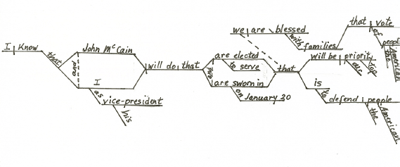One really needs to read Ms Florey's article to get the background, but since she clearly asked for help at one point, it seems a worthwhile project to see if anyone has ideas of how to crack the Palin Challenge.
From Ms Florey:
Other Palinisms are not so tractable. From the Charlie Gibson interview:I know that John McCain will do that and I, as his vice president, families we are blessed with that vote of the American people and are elected to serve and are sworn in on January 20, that will be our top priority is to defend the American people.
I didn't stop to marvel at the mad thrusting of that pet political watchword "families" into the text. I just rolled up my sleeves and attempted to bring order out of the chaos:
I had to give up. This sentence is not for diagramming lightweights. If there's anyone out there who can kick this sucker into line, I'd be delighted to hear from you. To me, it's not English—it's a collection of words strung together to elicit a reaction, floating ands and prepositional phrases ("with that vote of the American people") be damned. It requires not a diagram but a selection of push buttons.
There you have it. Anyone who thinks he or she is up to the Palin Challenge is welcome to take a shot at it. Or, if anyone feels the urge to try to diagram any of Palin's other sentences, feel free. Who knows, it might become a growth industry.

5 comments:
I still have no friggin clue what kind of diagramming this is. It looks very screwball and confusing to me. Much more comfortable with syntactic trees.
These are known as Reed-Kellog diagrams, named after Alonzo Reed and Brainerd Kellogg, who described their method in two books first published in the 1870s. Anyone who went to high school up through the 50s or early 60s is likely to have learned this system. Afterwards, not so much. Grammatical theory has changed since then and Reed-Kellog diagrams are no longer considered fully compatible with more recent theories.
If you google "sentence diagramming" or "Reed-Kellog diagrams" you will find more than you probably want to know about sentence diagrams. Or you could start with the Wikipedia entry, but it's not very well illustrated.
Syntactic trees (or x-bar theory trees) are primarily tools for linguists studying language. Reed-Kellog diagrams are meant for students of a particular language to make the specific relationships of the various parts of a sentence visible and hence more easily understood.
And generally speaking, anything one doesn't understand is likely to look screwball and confusing.
@Frankly
Oh, no I can get the basic idea that it apparently branches off modifiers and such. Definitely agree that it doesn't jive well with modern theories--I'll have to read on it to make sure but it definitely doesn't seem to work well with constituent theory.
In any case, whatever framework you're working with -- a good deal of conversational speech is likely to be difficult to diagram. In normal conversations, people will hesitate, abandon unfinished sentences, commit various errors, etc. Although I agree that Palin is unqualified and really quite ill-informed, I don't think that an inability of people to fully diagram her speech is what reveals that.
No, Root-Kellog diagrams are very much tied to the old "parts of speech" concept of language analysis and don't suit modern linguistic concepts well at all.
And yes, sentence diagramming is very much more applicable to written language than spoken language. If you look at Kitty Florey's article you'll see that she mentioned this and the entire piece was very much tongue-in-cheek. But even so, Palin is more than usually prone to loop back on herself in her sentences which seem to ramble on interminably. Here is a classic from the debate: "Uh, nukuler weaponry, of course, would be the be-all, end-all of just too many people and too many parts of our planet so those dangerous regimes again cannot be allowed to acquire nukuler weapons, period." Not only does this defy diagramming, it is barely English. The obvious goal here is simply to keep pumping out words until 90 seconds have elapsed.
But speaking of revealing, don't miss the Palin debate flow chart.
Thanks for this, F,MD!
I did learn that same system of diagramming sentences in the late 60's and had a lot of fun with it, as I recall.
Perhaps we should offer a prize, just in case we get any takers who actually succeed?
Post a Comment